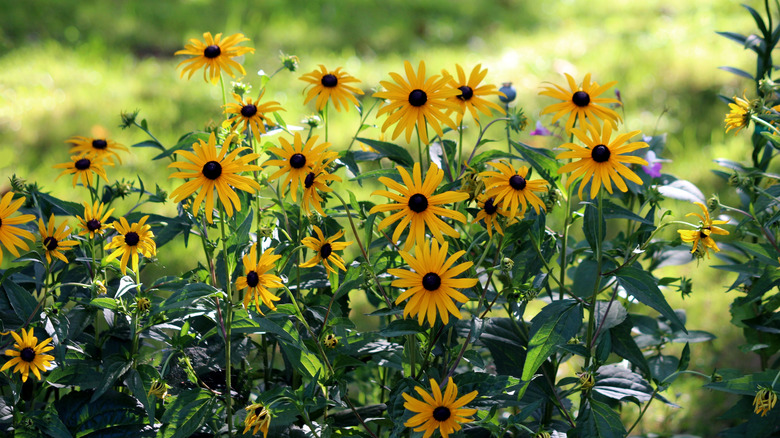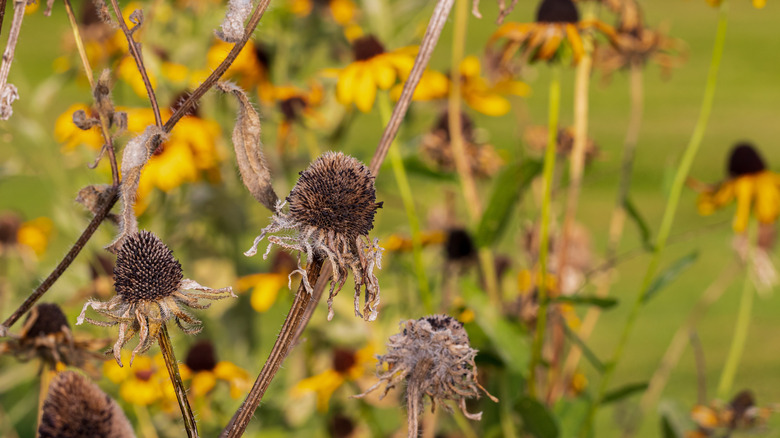Care For Black-Eyed Susans In The Fall For Bigger And Better Blooms Next Year
Black-eyed Susans (Rudbeckia hirta) are among the easiest flowers to grow. Native to North America, they're well-adapted to growing in a wide variety of soil types and levels of sunlight. Plant seeds in spring, and they'll produce abundant blooms the same year. Let the flowers turn to seed, and they'll spread easily — sometimes too easily if you don't want them taking over your garden. Plus, you'll be attracting butterflies, bees, and other pollinators, and you'll keep birds flocking to your yard to snack on the seeds into the winter if you leave the flower heads up. Want bigger and better blooms the following year? You could just leave them alone, as they'll produce no shortage of flowers. But to ensure that these short-lived perennials produce the best blooms while they live, there are a few steps you can take to care for your black-eyed Susans in the fall.
Black-eyed Susans thrive in USDA Hardiness Zones 3 through 8. They're not picky where they grow: They can tolerate full sun to partial shade, acidic and alkaline soils, clay and sandy soils, moist and occasionally dry soils, and anything in between, though the more sun you give them, the more blooms they'll give back. Plant them among coneflowers (Echinacea purpurea), coreopsis (Coreopsis grandiflora), and bee balm (Monarda didyma) to create a pollinator-friendly native wildflower garden. None of these plants need much care, but since black-eyed Susans are short-lived perennials, you'll want to help them as much as you can this fall to give them the best chance of producing ample blooms next year. To extend the life of your black-eyed Susans, lay down a warm blanket of mulch around their base late in fall. This will keep away the worst of winter's cold.
Fall care for your black-eyed Susans
Surrounding your black-eyed Susans with three inches of mulch will lock in moisture and the lingering warmth of the sun, allowing the roots to better weather the cold of winter. Just don't overdo it: More than three inches will compress the mulch, making it harder for oxygen and moisture to reach the plant's roots. To prevent slugs, aphids, and fungal diseases that can harm the plant, rake up any leaves or wilted blooms from around the base of the plant before laying down the mulch, and keep it away from the stems of the plants themselves, as the moisture retained in the mulch can lead to stem rot. And there's no good reason to rush, as black-eyed Susans can bloom for a long time into the fall. No harm is done waiting until just before the first frost, when you can then add them to your fall to-do list.
There are a lot of good reasons not to prune your black-eyed Susans in the fall, especially in terms of supporting local wildlife. It's often recommended that you wait until spring to cut back the plants, but if you'd rather keep your black-eyed Susans contained to the place where you planted them, cut back the top four inches above the leaves using clean, sharp gardening shears. Leave any green leaves on the plants, as this will allow them to continue photosynthesizing and storing the sun's energy in their root system. This will keep the roots and remaining stems strong and disease-free. In early spring, remove the mulch from around the plants so that the new seedlings have an easier time emerging. With just a little fall care, your plants will be happier, stronger, and bursting with blooms come summer.

